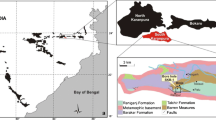The palynostratigraphic data given here are based on the explored borecores (TRBD-2, TRBD-3 and TROD-1), by Geological Survey of India. The Permian strata worked-out is about 1174.00 m thick and comprises from base to top – Talchir, Barakar and Barren Measures formations. The palynological content enables delimitation of five palynological assemblages. (i) Scheuringipollenites barakarensis, (ii) Faunipollenites varius, (iii) Gondisporites raniganjensis, (iv) Densipollenites magnicorpus, and (v) Krempipollenites indicus in ascending order from the subsuface rock strata. The lithologically identified strata Talchir Formation in borecores TRBD-2 and TRBD-3 is palynologically dated late Early Permian in having the Scheuringipollenites barakarensis and the Faunipollenites varius palynozones. Subsequently, the part of Barakar strata in these borecores corroborates with Barakar Formation. In borecore TRBD-3, the Barren Measures rocks do not match with the palynological dates, and are affiliated with the palynoflora of the Raniganj Formation. In TROD-1, the strata identified as Barakar Formation is dated Late Permian in having Gondisporites ranigangensis Palynozone; while that of Barren Measures Formation is palynologically dated Early Triassic having Krempipollenites indicus Palynozone. The palynology has helped in the precise dating of the Lower Gondwana succession of Odari and Bartikhurd blocks in Tatapani–Ramkola Coalfield of South Rewa Gondwana Basin.
Similar content being viewed by others
References
Bose M N, Banerji J and Maithy P K 1977 Some fossil plant remains from Ramkola–Tatapani Coalfields, Madhya Pradesh; Palaeobotanist 24 108–117.
Raja Rao C S 1983 Coal resources of Madhya Pradesh and Jammu & Kashmir; Bull. Geol. Surv. India Series A, No. 45, Coalfields of India III, pp. 1–204.
Srivastava S C and Ratan Kar 2001 Palynological dating of some Permian outcrops from Iria valley, Tatapani–Ramkola Coalfield, MP, India; In: Proceeding of National Seminar on Recent Advance in Geology of coal and lignite basins of India, Calcutta, Geol. Surv. India Spec. Publ. 54 97–102.
Srivastava S C, Prakash A and Ratan Kar 1997 Palynology Permian–Triassic sequence in Ira nala, Tatapan–Ramkola, Coalfield, India; Palaeobotanist 46(1, 2) 75–80.
Tiwari R S and Tripathi A 1992 Marker assemblage zones of spore and pollen species through Gondwana Paleozoic and Mesozoic sequence in India; Palaeobotanist 40 194–236.
Vijaya, Tripathi A and Ram-Awatar 2001 Vertical distribution of spore and pollen index species in the Permian sequence on Peninsular India; In: Contribution to geology and paleontology of Gondwana (ed.) R H Weiss, Germany, pp. 475–495.
Author information
Authors and Affiliations
Corresponding author
Rights and permissions
About this article
Cite this article
TRIPATHI, A., VIJAYA, MURTHY, S. et al. Stratigraphic status of coal horizon in Tatapani–Ramkola Coalfield, Chhattisgarh, India. J Earth Syst Sci 121, 537–557 (2012). https://doi.org/10.1007/s12040-012-0161-2
Received:
Revised:
Accepted:
Published:
Issue Date:
DOI: https://doi.org/10.1007/s12040-012-0161-2




